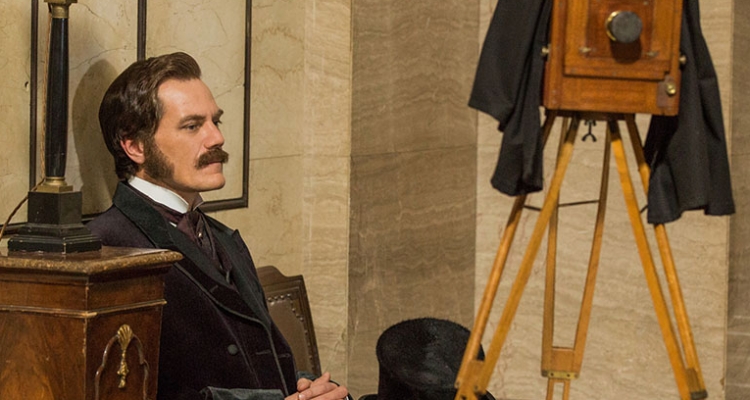TORONTO – History tells us there was a long, protracted battle for the electrical current business in the United States beginning in the 1880’s. This was a highly lucrative turf war to determine how cities would provide electric light to their constituents for generations. This was an invention that changed the world almost as quickly as the automobile, jet airliners, television or the iPhone.
Thomas Edison, arguably the greatest inventor the world has ever seen, struck out with his own direct current (DC) company to in 1882. George Westinghouse launched an alternating current (AC) company four years later. At the worst, their bitter contest to dominate a world-changing field should make for an intriguing period drama. At the best a noteworthy reminder of how ingenuity and competition transformed the globe at lightning speed. And yet somehow any of the story’s real life suspense is completely lost in Alfonso Gomez-Rejon’s over-stylized “The Current War” which debuted at the 2017 Toronto International Film Festival this weekend.

Edison (Benedict Cumberbatch, sleepwalking) and Westinghouse (Michael Shannon, the only pulse the movie has) became rivals when the former believed the latter stole his invention with a modified patent for the AC current. As the movie depicts it, however, Westinghouse didn’t even see it as much of a battle. He wasn’t out to destroy Edison, but just push his own product in hopes of getting the biggest market share possible. Michael Mitnick’s screenplay, however, frames Edison as obsessed with taking down Westinghouse via increasingly desperate measures.
A major celebrity of the era, Edison uses his influence with the press to insist people could die from the “dangerous” AC current and eventually even schemes to have Westinghouse’s AC generator power the first electric chair. Westinghouse, meanwhile, continues to take the high ground as his wife, Marguerite Erskine (Katherine Waterston, fine pt. 1), encourages him to persevere.
As both men’s companies try to win different contracts in cities across the nation it becomes increasingly clear Westinghouse’s cheaper system is taking the lead (imagine that) and Edison faces increasing pressure from principal investor J.P. Morgan (Matthew Macfadyen, a little too on the nose) to stop hemorrhaging money and take Westinghouse done. Both companies eventually stake their fortunes on securing the rights to light the 1893 World’s Columbian Exposition in Chicago aka the first Chicago World’s Fair (although Mitnick has taken some major creative liberties with the facts surrounding both companies involvement).
During this supposed battle of business titans, Westinghouse hires Edison’s former employee Nikola Tesla (Nicholas Hoult, memorable at least) and Edison’s right-hand man, Samuel Insull (Tom Holland, fine pt. 2), tries to warn his boss of the perils of continuing to push a more expensive system. And there’s that whole electric chair mess that Edison gets himself wrapped up in which seems like it’s meant for another film entirely.
Again, this seems like at least a somewhat compelling narrative to explore, no? Perhaps on paper, it was, but Gomez-Rejon’s direction effectively neuters any of the genuine dramatic tension in the source material. The filmmaker and his editor, David Trachtenberg, basically edit the movie to within an inch of its life. Scenes transition so quickly for a good two-thirds of the film that you begin to wonder whether a huge chunk of the script was cut out or it was so flimsy to begin with that Gomez-Rejon and Trachtenberg felt they had to go to extremes to just attempt to make it visually interesting. Composers Volker Bertelmann and Dustin O’Halloran provide alternating traditional and electronic scores that somehow make the whole endeavor even less appealing (the movie feels like there is constant score even if you can’t remember the melodies distinctly).

This critic was an unwavering fan of Gomez-Rejon’s last film, “Me and Earl and the Dying Girl” which makes his efforts with “The Current War” even more disappointing. While Gomez-Rejon used imaginative visual ideas for that coming of age story he also distinctly let that movie breathe when it needed to. It felt grounded when it needed to. In this case, almost every decision seems to have been overthought. It gets to the point where the movie feels like an extended music video or a series of historical vignettes visually designed to keep middle school students (or visitors to a Natural History museum) from falling asleep. A perfect example is the movie’s climax. It should be a gorgeous, wide shot full of light and wonderment (you can guess what it is, but we won’t spoil it). Instead, Gomez-Rejon and Trachtenberg split the screen into three separate windows featuring different, smaller shots that effectively kills the moment.
The only aspect of the film that even makes it watchable ends up being Shannon’s portrayal of Westinghouse. The actor is certainly better in his other upcoming release, “The Shape of Water,” but he’s the only participant in “Current” who doesn’t seem in a rush. He lets Westinghouse ponder. He lets him soak in the events around him. Outside of a few fleeting moments from Hoult’s Tesla — in scenes with Shannon present it should be noted — he gives a performance meant for a movie that “The Current War” could have and should have been. [C]
Click here for our complete coverage of the 2017 Toronto International Film Festival


